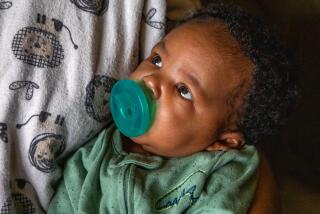How to Make Households Safe for Small Occupants
- Share via
Every year, nearly 4.5 million children ages 14 and younger are injured in the home, according to the National Safe Kids Campaign.
And an estimated 2,700 kids will die of their injuries, according to the National Center for Health Statistics.
Most of the injuries are preventable, said Angela Mickalide of Safe Kids, which tries to raise awareness among parents and caregivers that preventable injuries are the leading health threat facing children in America today.
Here are the danger spots in a home and some prevention tips from child safety experts and emergency room doctors:
Bathroom. From the perspective of physicians who treat children in hospital emergency rooms, the room that bears the most scrutiny is the bathroom.
“It’s a place where bad things can happen,” said Dr. Martin Eichelberger, a pediatric surgeon and trauma specialist at Children’s National Medical Center in Washington, D.C. Eichelberger also co-founded in 1988 the National Safe Kids Campaign.
The first thing he recommends is a single-lever, anti-scald faucet for the bathtub and shower.
Now required for new construction in most of the U.S., the anti-scald faucet should be considered for retrofitting bathrooms.
The faucet is laudable for two reasons. First, the faucet has a maximum hot-water setting. Second, the faucet is pressure balanced so that when it is turned on and adjusted to a desired temperature, the ratio of hot and cold water will remain the same, regardless of other plumbing fixtures in use at the time.
About 80% of the time when children are severely burned, the cause is scalding, Eichelberger said.
“The skin of children under the age of 5, and especially those under age 1, is so thin that it only takes three to five seconds of exposure to water at 140 degrees for the child to get a third-degree burn,” he said.
Eichelberger said 120 degrees is “a safe temperature. Even if a small child is exposed, the probability of a significant burn is low.” But it is hot enough for most adults.
(Some homeowners mistakenly think the hot water heater must be set higher than 120 degrees to ensure that the water in the dishwasher is hot enough to adequately clean the dishes. Dishwashers have their own heating elements, noted Dr. Malvin Weinberger, a pediatric surgeon at Miami Children’s Hospital.)
More bathroom safety tips:
A temporary locking device for the toilet seat prevents toddlers from falling in.
Though it is rare, toddlers can drown in a toilet for the same reason they can drown in a scrub bucket--they develop the muscle strength to pull themselves up to look into the toilet or bucket before they have the strength to push themselves out if they fall in.
An added benefit of toilet locks: They keep kids from putting things down the toilet that require a plumber to clear the line.
Locks on bathroom doors should be made inoperable so that small children can’t lock themselves in, said Mimi Sutherland, a nurse and trauma safety specialist at Jackson Memorial Hospital in Miami.
Most bathroom locks can be unlocked from the outside with a pointed object such as a scissors, but you don’t want to have to waste time doing this in an emergency, Sutherland said.
Stairs. Most parents know that, once children start crawling, stair gates are necessary.
But many people don’t realize that stair gates don’t fit very well on some types of rails, said Patti Laird of Miami, a child safety expert who focuses on the home and a member of the New Jersey-based International Assn. for Child Safety.
With wrought-iron rails, for example, you have to attach a piece of wood to the iron rail to mount one side of a semi-permanent swing gate, said Laird, who runs a company called Safer Kids and Homes.
And parents shouldn’t assume a spring-loaded stair gate is the solution, she said. While this type of gate will work on a temporary basis--say, when visiting grandparents--it’s a pain to take in and out every time you go up and down the stairs.
Inevitably, it won’t be used all the time, or parents will try to step over it, not a great idea when one is carrying a baby.
And at the top of a staircase, a spring-loaded gate is hazardous. A toddler can push against the gate, dislodging it so that both child and gate fall down the stairs.
Laird also raises concerns about the construction of the wall where parents want to put the gate.
One side of a swing-type gate attaches to a wall, and to ensure that the gate won’t move, it must be screwed into a wood stud behind the gypsum plasterboard. In new houses, Laird frequently finds there is no appropriate wall stud, so she has to add one.
“We try to make it look good, but no question, it’s visually awkward,” she said.
Windows. These are another feature Laird examines closely. Large windows that fill a house with daylight are a hallmark of new construction, but those big windows and low sills can pose a problem for children.
Parents must ensure that children can’t fall out--even if the house is one story.
From a child safety standpoint, double-hung windows are preferable, Laird said. The bottom half can be kept shut, while the top half--out of reach of small children--can be opened for ventilation.
If your only option is a single-hung window--the top half is fixed but the bottom is movable--Laird recommends latches that prevent the window from being opened more than three or four inches.
Though casement-type sliding windows offer the most ventilation potential, they are the worst for small children. If you have these in your home, be prepared to install window guards for every opening, Laird said.
Some parents mistakenly think that a screen serves the purpose of a guard, but “screens were invented and designed to keep tiny insects out, not people in,” Laird said. Most screens are held in by narrow rubber strips; anyone, including a small child, who leans on a screen can go right through.
Blinds and curtains. These common home accessories pose a danger to small children because they can get their heads caught in the cords.
To prevent this, the cord should never be a connected loop; it should always be a strand and tucked up high if possible. Since a baby in a crib can reach or use a toy to reach the cord, the crib should never be placed near a window.
Kitchen. Most parents know the safety basics in the kitchen. For example, when cooking, they usually know to turn all pot handles inward so a child cannot grab at a pot full of hot liquid.
But few realize that the stove itself can topple over on a child who pulls down the oven door to climb up. To prevent this, an anti-tip bracket must be installed on the back of the stove.
Small children are also at risk for having furniture tip over on top of them. A solution: Anchor dressers, changing tables, bookcases and anything else with tip-over potential to the wall.
(BEGIN TEXT OF INFOBOX / INFOGRAPHIC)
Resources
For more tips on how to keep children safe in the home, call (800) 289-0117 for the $11.99 Safe Kids Gear Up! guide and video.
The National Safe Kids Campaign has 231 chapters in 41 states. For more information on the group, call (202) 662-0600.
*
Any parent wanting the type of audit that Laird provides should contact the International Assn. for Child Safety in Parsippany, N.J., (888) 677-IACS, for a local referral.
More to Read
Sign up for Essential California
The most important California stories and recommendations in your inbox every morning.
You may occasionally receive promotional content from the Los Angeles Times.













